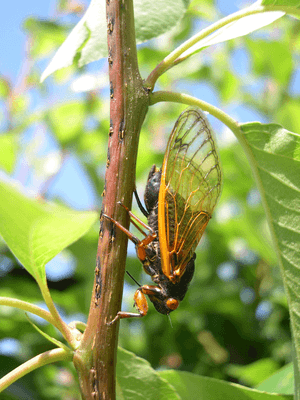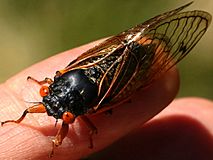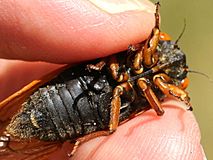Magicicada cassinii facts for kids
Quick facts for kids Magicicada cassinii |
|
|---|---|
 |
|
| Female ovipositing | |
| Conservation status | |
| Scientific classification | |
| Genus: |
Magicicada
|
| Species: |
cassinii
|
| Synonyms | |
|
Cicada cassinii Fisher, 1852 |
|
Magicicada cassinii, sometimes called the 17-year cicada, Cassin's periodical cicada or the dwarf periodical cicada, is a species of periodical cicada. It is endemic to North America. It has a 17-year lifecycle but is otherwise indistinguishable from the 13-year periodical cicada Magicicada tredecassini. The two species are usually discussed together as "cassini periodical cicadas" or "cassini-type periodical cicadas." Unlike other periodical cicadas, cassini-type males may synchronize their courting behavior so that tens of thousands of males sing and fly in unison. The specific name cassinii was in honour of John Cassin, an American ornithologist.
Contents
Description
The adult M. cassinii is very similar in appearance to other periodical cicadas. It is between 24 and 27 mm (0.94 and 1.06 in) long, measured from the front of the head to the tip of the wings folded over the abdomen. The head is black, the eyes are large and red, the pronotum is black apart from a narrow orange band at the edge of the sternites, and the abdomen is black. The legs are orange and the wings are translucent, with orange veins and dusky markings near the tips.
Distribution and habitat
Magicicada cassinii is endemic to North America, its range extending across the northern belt of the United States and the southern part of Canada.
Life cycle
These cicadas are true bugs and after having emerged from underground, the adults feed on sap sucked from trees and shrubs. Males amass in great numbers and sing in unison to attract females. The call lasts for two to four seconds and is a series of ticks followed by a drawn-out buzz which rises and falls in pitch. At the end of a chorus, males move to a new perch before starting the song again. After mating, the females insert their ovipositors into shoots and lay their eggs. These hatch about two months later and the first instar nymphs drop to the ground where they move underground and suck xylem sap from small rootlets. This sap is very low in nutritive value and the nymphs grow very slowly. They will moult five times, moving on to larger roots deep in the soil as they grow over a period of seventeen years. Finally, they all tunnel up through the soil and emerge into the open air, before climbing up the vegetation and shedding their skins for a final time to become adults. Although each population has a seventeen-year life cycle and emerges in synchrony, past environmental events have occasionally disrupted this pattern and there are several different broods in existence in various parts of the insect's range which emerge in different calendar years. In fact, their life cycle can range from thirteen to twenty-one years.
The different broods have been numbered, and the next emergence of Brood X is due to occur in Delaware, Georgia, Illinois, Indiana, Kentucky, Maryland, Michigan, North Carolina, New Jersey, New York, Ohio, Pennsylvania, Tennessee, Virginia, and West Virginia in May and June 2021. Many broods have a sub-brood that emerge a few years before the regular brood. The Brood XIII sub-brood in the Chicago area emerged 4 years early in 2020.
-
Male dorsal Brood XIII sub-brood, Naperville, Illinois June 13, 2020
-
Male ventral Brood XIII sub-brood, Naperville, Illinois June 13, 2020
Damage
In outbreak years, the cicadas do significant damage to the trees on which they lay eggs, especially saplings. The female cuts a slit in a twig in which to insert her eggs and this often causes the shoot to droop and defoliate. In larger twigs it may allow entry of disease organisms. The burden of feeding of the nymphs is also considerable. However, it has been shown that there is little long-term harm to mature trees.
Alleged reward for blue eyed cicadas
A popular reoccurring urban legend purports to say that rare blue (or white) eyed cicadas will fetch rewards of up to one million dollars. According to the legend, biological laboratories, particularly at Vanderbilt University, will pay a reward to any who catch such a specimen. And while it is true that blue eyed cicadas are extremely rare, occurring in only about one in every million insects, no laboratories currently offer any such reward. However, Roy Troutman, an American entomologist and cicada researcher, did in fact offer rewards for living blue eyed cicadas for cicada research in 2008. He is no longer offering rewards.




